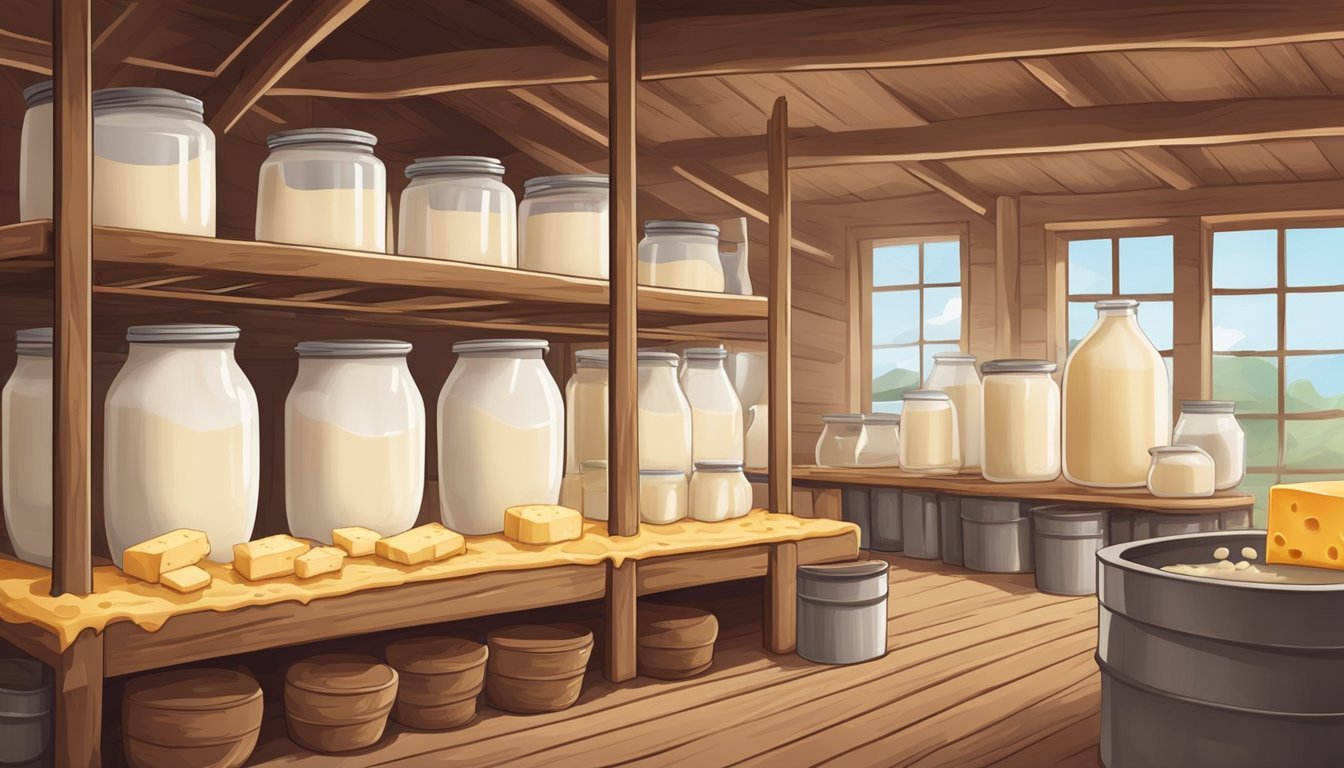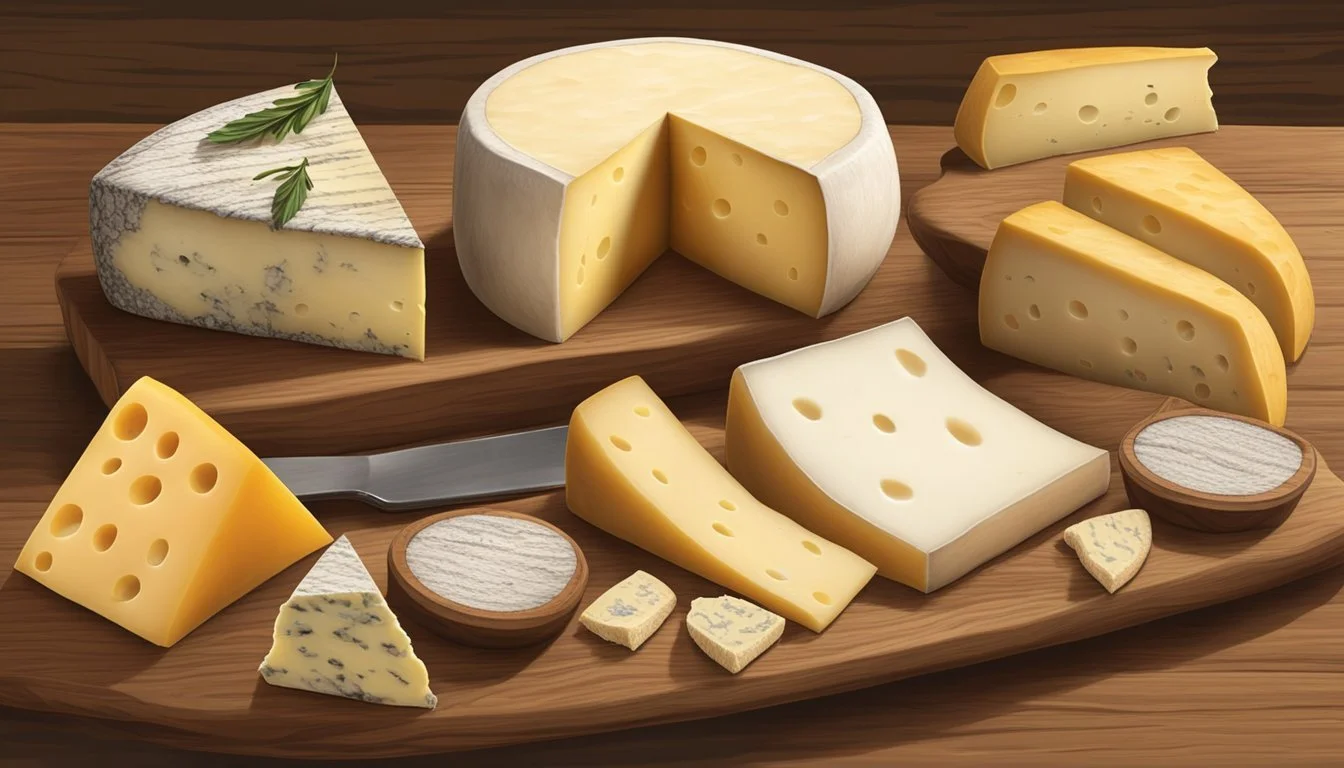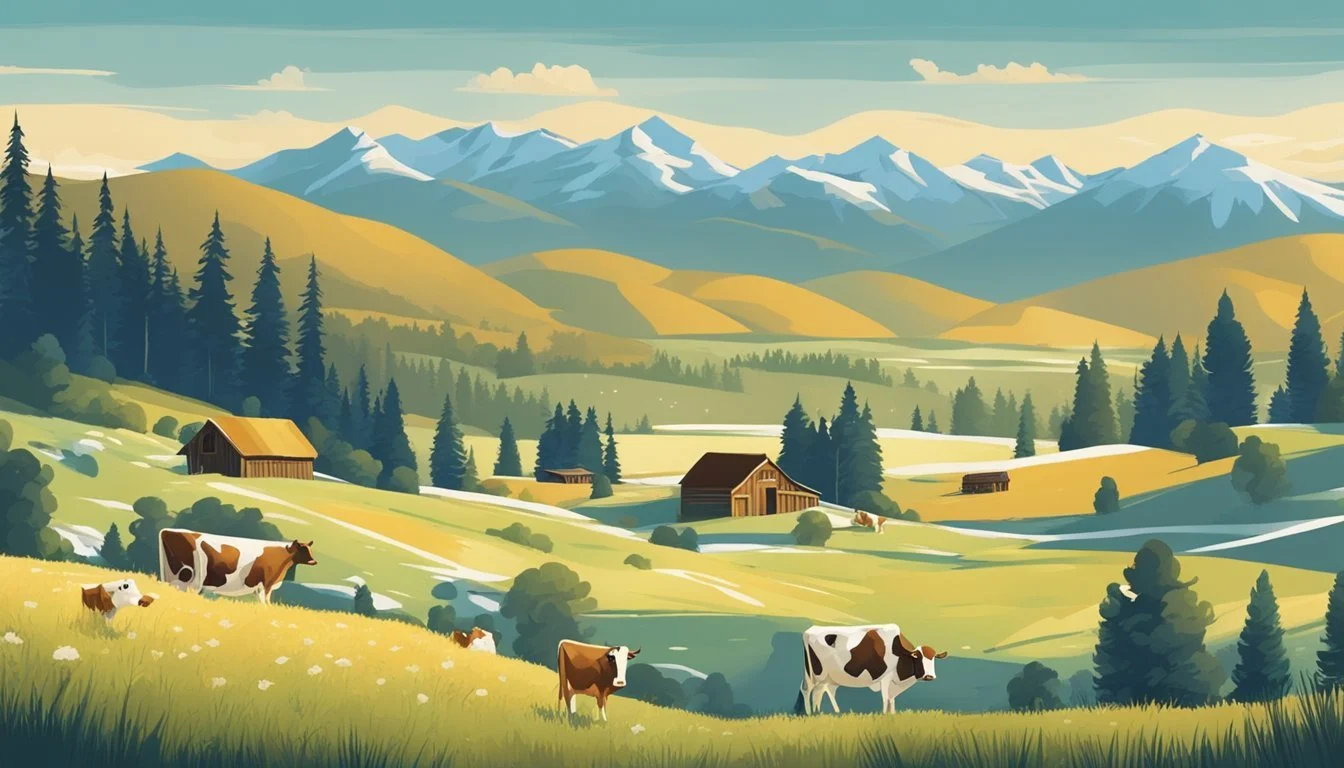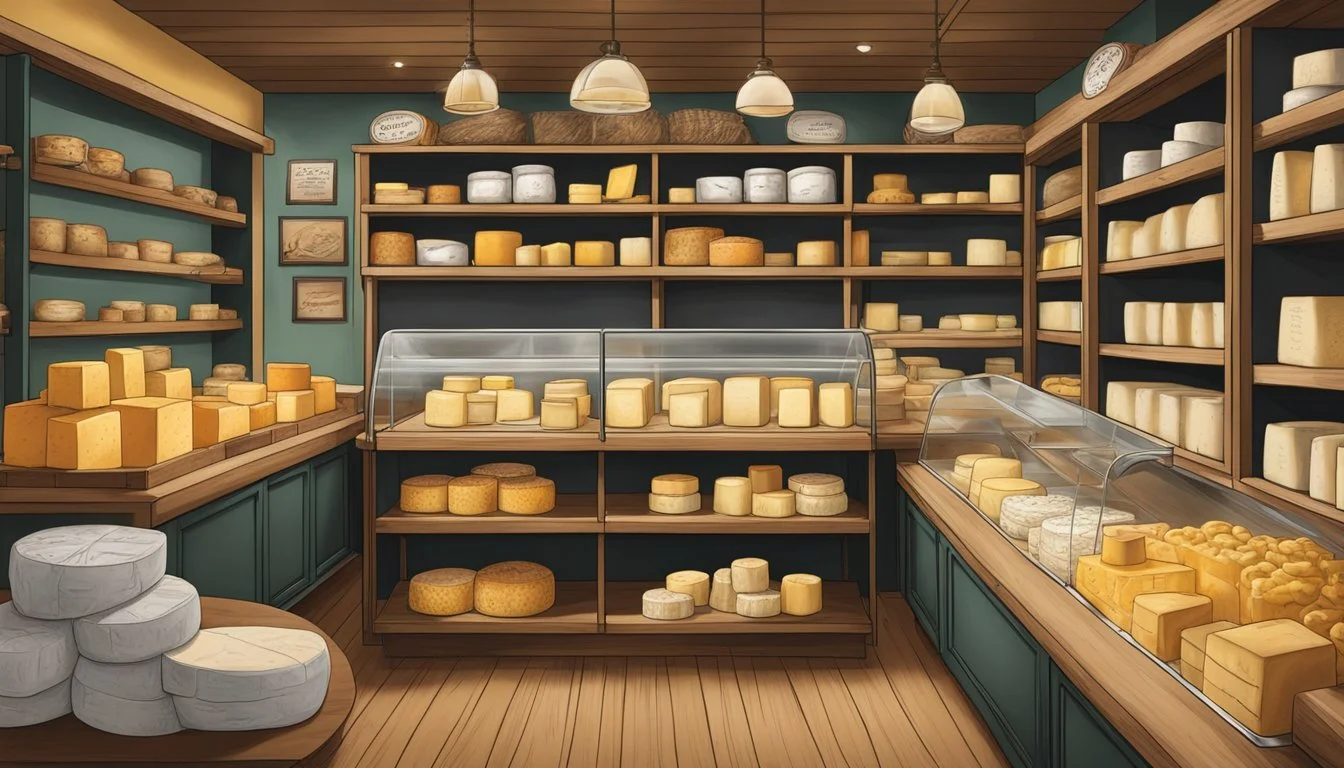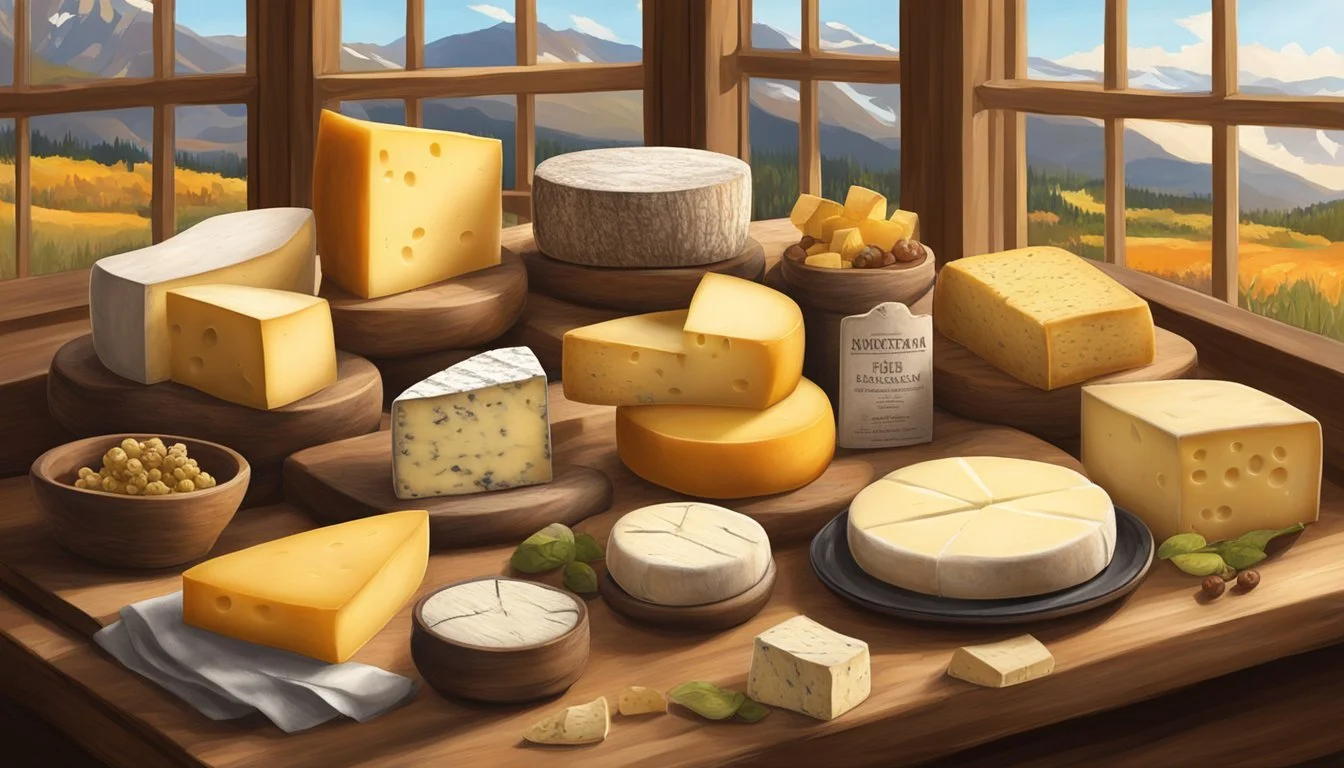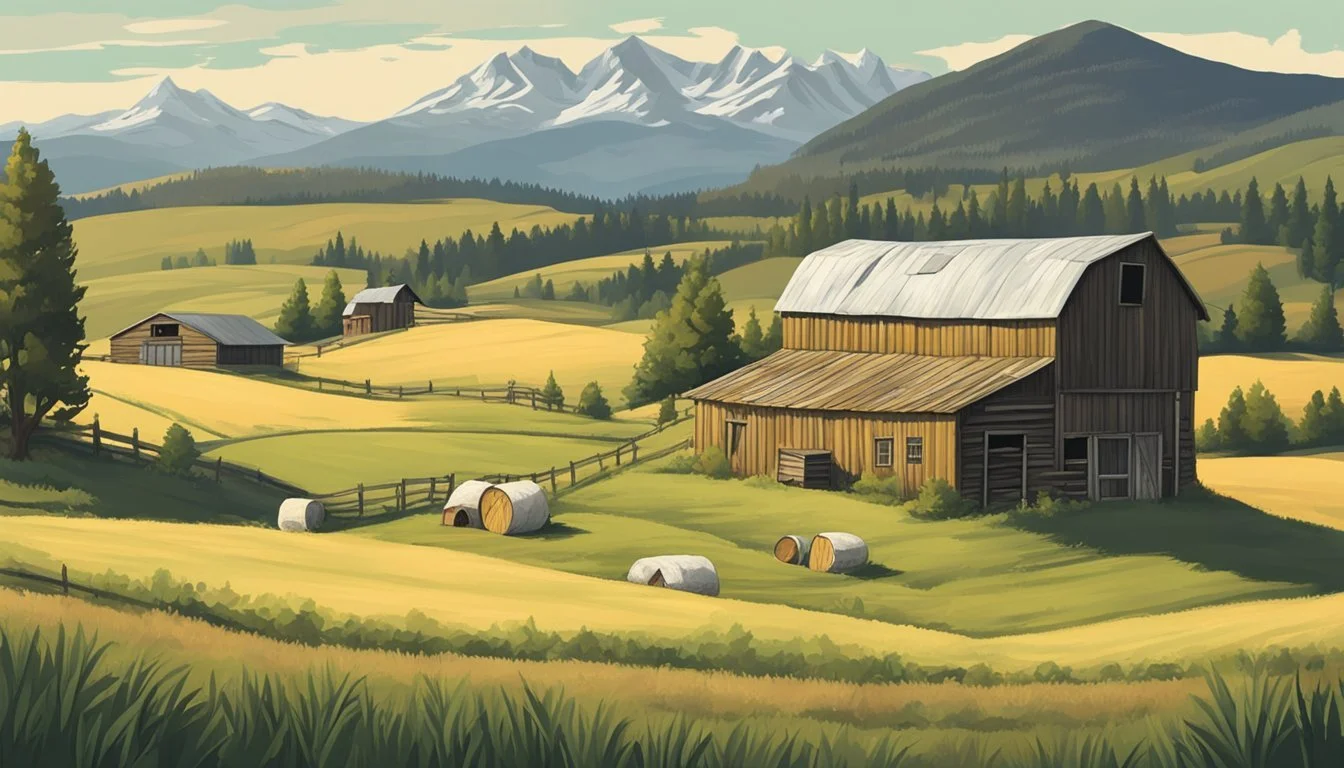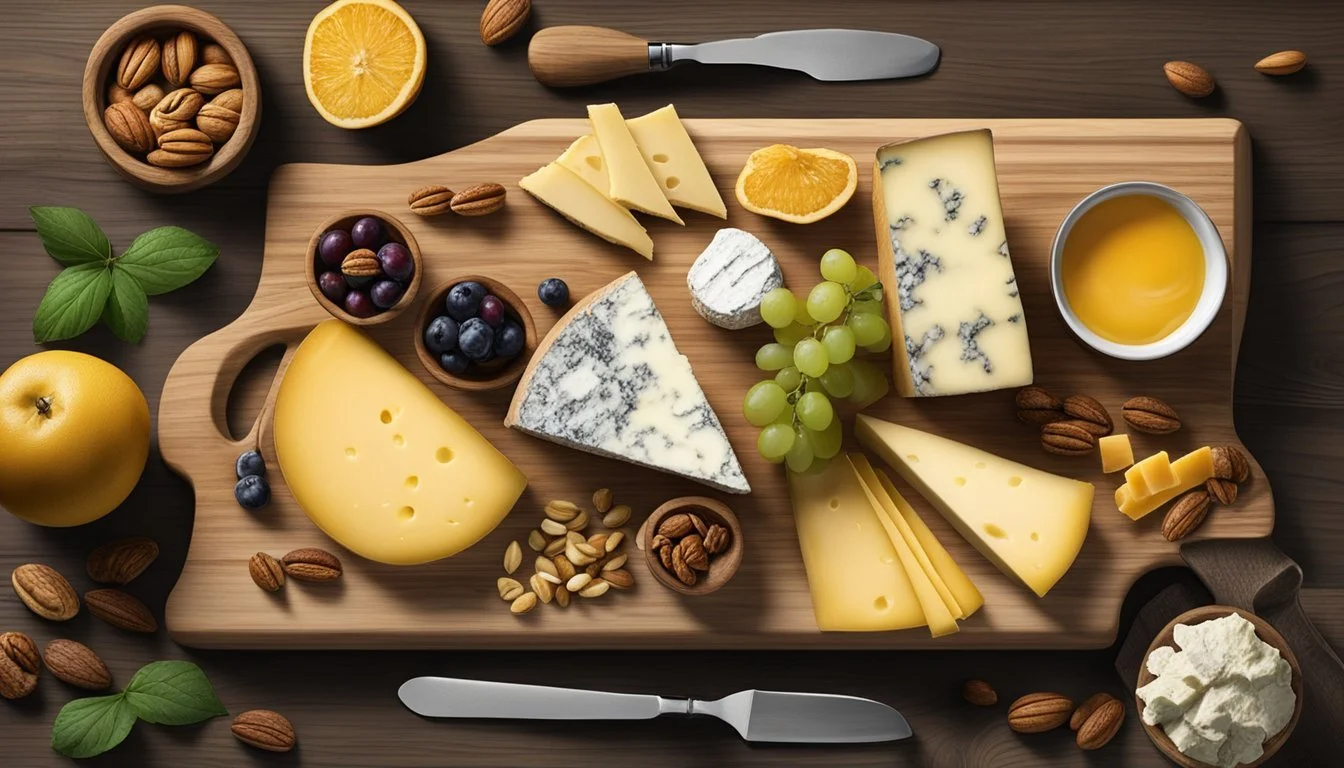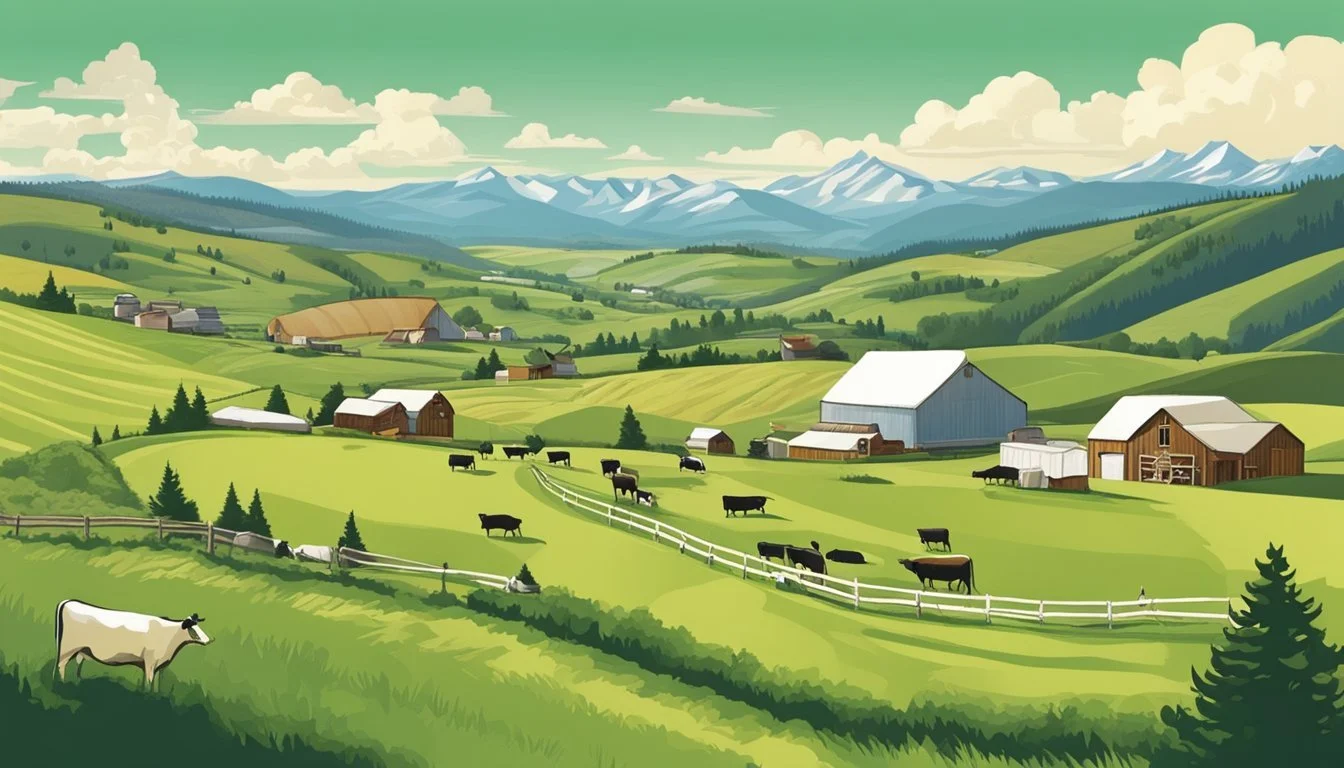Montana Artisan Cheese
Savoring the Big Sky Country’s Finest Flavors
Montana artisan cheese (how long does cheese last?) encompasses an array of high-quality, handcrafted cheeses that reflect the state’s commitment to purity and tradition. Crafted from fresh organic milk sourced from local dairies, these cheeses are notable for their rich butterfat content. Montana's cheese artisans adhere strictly to the use of non-GMO ingredients and avoid the use of antibiotics, growth hormones, or rBST in their dairy cows. This painstaking attention to detail and quality ingredients contributes to the distinct taste and texture found in Montana's artisan cheese offerings.
The varieties of cheese produced in the Big Sky State span a wide range of flavors and styles, including, but not limited to, Chevre, Ricotta, Feta, Colby, Cheddar, Cabra Al Vino, Bjerg, and Mozzarella, using both goat’s and cow’s milk. These cheeses are the result of clean air, healthy cows grazing on pristine farmlands, and the tireless efforts of skilled artisans. Factors such as location, recipe, ingredients, and aging process all combine to give each cheese its unique identity that is true to the artisanal spirit of Montana cheesemaking.
Montana's Cheese Heritage
Montana’s rich cheese heritage is rooted deeply in its sprawling pastures and history of dairy farming, influenced heavily by European traditions. This tradition has morphed into a burgeoning artisan movement, with key figures shaping the state's cheese-making landscape.
Influence of European Cheesemaking
European cheesemaking techniques have had a significant impact on Montana's dairy industry. Settlers brought their cheese-making practices from countries renowned for their cheese, such as Switzerland, France, and Italy. These methods were adapted to Montana's unique environment, where the pure and organic milk from local cows is used to create cheeses with high butterfat content. Montana has maintained strict standards for cheese production, ensuring that no antibiotics, growth hormones, or rBST are used.
Growth of Artisan Movement in Montana
In recent years, the artisan cheese movement in Montana has gained momentum. Local cheese makers leverage the state's clean air and healthy cows to craft high-quality artisan cheeses. These artisans utilize organic, non-GMO ingredients provided by Montana’s dairy farms to produce various styles of cheese, from traditional cheddars to unique, Alpine-style creations. The state’s reputation for premium quality dairy products is continually growing due to these efforts.
Key Figures in Montana Cheese History
The evolution of Montana's cheese industry can be attributed to influential cheese makers who have left a lasting impact. Among these, third-generation cheese makers like the Heap family from Bozeman have played a pivotal role. With their award-winning Mountina Cheese, an Alpine-style cheese noted for its sweet, nutty flavor, they have positioned Montana on the artisan cheese map. Other artisan cheese producers contribute to the state’s cheese narrative by creating products that encapsulate the character of Montana with each variety they produce.
The Cheese Making Process
In Montana's local creameries, the transformation of milk into artisan cheese is an intricate process. Employing traditional methods and modern technology, these creameries produce a range of exquisite cheeses that reflect the region's distinct flavors.
Selection and Treatment of Milk
The first step in cheese making is choosing high-quality milk, which is often sourced directly from Montana's dairy farms. This milk can come from cows, goats, or sheep, depending on the type of cheese being produced. At the creamery, the milk undergoes pasteurization to eliminate harmful bacteria and homogenization to ensure a consistent texture, although some artisan cheeses are made from raw, unpasteurized milk to maintain specific regional flavors.
Culturing and Curdling
The next phase involves adding cultures to the milk to begin the fermentation process. These cultures are specific strains of bacteria that acidify the milk and play a crucial role in developing the cheese's flavor and texture. The temperature is carefully controlled to encourage optimal growth of the cultures. Following this, a coagulant, often rennet, is introduced to solidify the milk into a gel-like substance. This thickened milk is then cut into curds, with the remaining liquid being the whey. The size of the curds can affect the moisture content and texture of the cheese.
Aging and Storage Techniques
Finally, the curds are either pressed into molds and aged to develop their unique flavors or sold as fresh cheese. Aging can occur in various environments, such as temperature-controlled rooms or natural caves, which impart distinct characteristics to the cheese. Aged cheeses (What wine goes well with aged cheeses?) can mature from a few months to several years. Throughout the aging process, cheeses may be turned, brushed, washed, or pierced depending on the type, to ensure even maturation and the development of desired textures and flavors.
Types of Montana Artisan Cheese
Montana's natural environment contributes to the crafting of a distinctive array of artisan cheeses. Cheese enthusiasts can enjoy a variety of locally made selections, from traditional favorites to innovative creations that capture the essence of Montana's dairy craftsmanship.
Popular Cheese Varieties
Round Clothbound Cheddar: A staple in the cheese world, Montana's cheddar is known for its rich butterfat content and is crafted using traditional methods. It stands out for its creaminess and depth of flavor.
Gouda Cheese: This smooth, slightly sweet cheese is a Dutch classic that's found a home in Montana. The state's artisans produce a traditional version known colloquially as Hoppin' Mad Gouda, enriched with local nuances.
Feta Cheese: With a crumbly texture and a tangy taste, Montana feta is typically made from whole milk, presenting a fresher and creamier alternative to its overseas counterparts.
Emerging Local Favorites
Chevre (Goat Cheese): This versatile fresh cheese is made from goat's milk and is cherished for its soft, spreadable texture and tart flavor. Montana producers are exploring new ways to infuse local terroir into each batch.
Ricotta: Not just for lasagna, this fresh cheese with its light, airy consistency is crafted in Montana from whey, a by-product of other cheese-making processes, ensuring a full circle of sustainability and flavor.
Colby: This American original, akin to cheddar but softer and milder, is receiving a local makeover. Montana's artisanal colby brings a buttery taste and a uniquely flexible texture that makes it perfect for melting or snacking.
Pairing with Montana Wines
When pairing these local cheeses with wine, one should consider Montana's own vineyards for a full local experience. For example:
Cheddar: Pairs well with Montana's bold reds, such as a local Cabernet Sauvignon, which complements its richness.
Gouda: Try it with a Merlot, whose soft tannins and fruity notes can highlight gouda's creamy texture.
Feta: Best with a crisp white wine, like a local Pinot Gris, to balance its saltiness.
Each cheese has the ability to enhance and be enhanced by the right wine, propelling Montana's culinary reputation to new heights.
Notable Montana Cheesemakers
In Montana, a commitment to quality and sustainability defines the state’s cheesemaking. The following cheesemakers have distinguished themselves through unique approaches and techniques.
Amaltheia Organic Dairy’s Sustainable Approach
Amaltheia Organic Dairy stands out for its sustainable practices and commitment to organic principles. They produce cheese using milk from their own herd of goats, ensuring that everything from feed to finished product adheres to strict organic standards. Their cheeses, like the creamy Chevre and the distinct feta, not only offer a delectable taste but also reflect their dedication to environmental stewardship.
Flathead Lake Cheese’s Craftsman Techniques
At Flathead Lake Cheese, artisanal expertise is paramount. This creamery is known for its craftsman techniques and a diverse selection of cheeses. Cheesemakers here employ traditional methods to craft products like their 'Hoppin’ Mad Gouda,' which has gained a following for its innovative flavor profile. They manage to strike a balance between age-old cheesemaking methods and creative ingenuity.
Innovative Products by Big Sky Cheese
Big Sky Cheese is an innovator in the Montana cheese scene, focusing on high-quality, pure ingredients. Their offerings, made from organic cow's milk sourced from local dairies, boast high butterfat content, free from antibiotics, growth hormones, or rBST. Non-GMO standards are a cornerstone of their production, ensuring that each variety they offer, from cheddar to mozzarella, meets a high standard of purity and taste.
Economics of Artisan Cheese
The economics of artisan cheese-making, particularly in Montana, reflect a robust interest in premium, locally-made products that align with consumer trends towards natural and artisanal foods.
Market Demand and Trends
The market for artisan cheese is driven by a growing consumer interest in high-quality, flavorful, and locally-sourced foods. Cheese curds and other artisan cheese types are increasingly sought-after at farmers markets and gourmet food outlets across the United States. Trends suggest a preference for cheeses that offer a unique taste experience, often connected to the regional characteristics of where they are produced. Artisan cheese, including award-winning varieties recognized by the American Cheese Society, continues to captivate consumers who are willing to pay a premium for these specialty products.
Montana Cheese in the National Context
Montana's artisan cheese-makers contribute to the national landscape with their distinctive cheese varieties, which are characterized by the state's unique flora and environmental conditions. While they are part of a larger American market, Montana cheesemakers face specific economic challenges and opportunities. The price parity with cheeses made from cow, goat, and sheep milk across small-scale producers allows for a competitive edge, given that artisan cheese can command similar retail prices to those of larger producers despite higher production costs.
Exporting Montana Cheese
Montana's artisan cheese is gaining a reputation beyond the state's borders. Exporting these products presents an opportunity for economic growth among local cheesemakers, expanding their reach to a broader audience. As demand for high-quality, American-made cheeses grows, Montana producers are well-placed to capitalize on this opportunity. Export efforts contribute significantly to the overall economic viability of the state's cheese-making industry, potentially opening up international markets for these specialty products.
Sustainability and Organic Practices
Artisan cheese makers in Montana are increasingly embracing sustainability and organic methods in their production processes, keenly focusing on the environmental impact and health aspects of cheese making.
Organic Milk Production
Organic cheese production starts with milk from cows or goats that graze on pesticide-free pastures. Montana is home to dairies such as Big Sky Cheese and Amaltheia Organic Dairy, where animals are raised without the use of antibiotics, growth hormones, or rBST, ensuring the milk is as natural as possible. Big Sky Cheese emphasizes the use of fresh, organic, whole cow's milk with a high butterfat content, which is a crucial element in producing rich and flavorful cheeses.
Dairies often feed their livestock with organic feed, like corn, alfalfa, and grass, which not only maintains the animals' health but also enhances the quality of the milk. By avoiding the use of synthetic chemicals, cheese producers ensure that the end products remain pure and free of unwanted residues.
Impact on Local Ecosystems
The sustainability of cheese production is closely tied to its effects on local ecosystems. Producers who embrace organic practices contribute to the health of the environment by reducing chemical runoff, which can otherwise harm nearby flora and fauna.
Montana artisan cheese makers, like those at Amaltheia Organic Dairy, strive for a closed-loop system, utilizing all by-products. Organic whey, a by-product of the cheese-making process, is repurposed to feed pigs, which are then also sold by the dairy as organic pork. This practice minimizes waste and creates additional revenue streams for the farmers. Moreover, composted manure from the animals is used to fertilize crops, promoting a nutrient-rich soil structure for grass and feed growth, thereby encouraging regular rainfall absorption and a healthier ecosystem.
Sustainable practices ensure that artisan cheese production in Montana enriches the environment while yielding high-quality cheese that benefits both consumers and the region.
Consumer Insights
In Montana, artisan cheese has cultivated a significant following, with consumer behavior and perceptions providing insight into this growing market segment.
Purchasing Behaviors
Consumers tend to seek out Montana artisan cheese for its quality and wholesomeness. Purchasing trends indicate a preference for cheeses that are perceived as more organic and sustainable. Many are willing to pay a premium for cheeses made from whole milk, associating them with a richer taste and texture. The following points have been noted in consumer behavior:
Preference for local products: Consumers often choose local artisan cheeses at farmers' markets and specialty shops.
Price sensitivity: Although willing to pay more for higher quality, there is a limit to price elasticity.
Packaging and labeling: Information about the cheese, including its organic certification and whole milk content, significantly influences purchasing decisions.
Regularity: Those who buy artisan cheese tend to do so on a regular basis, indicating strong brand loyalty.
Perceptions of Montana Cheese
Perceptions surrounding Montana artisan cheese highlight its feel and connection to the local landscape and farming practices. Consumers often describe Montana cheese as:
High-quality: Artisan cheeses from Montana are perceived to be superior in quality due to the attention to detail during production.
Health-conscious: There is a common belief that Montana artisan cheese, often produced with organic practices, is a healthier option.
Environmentally friendly: Sustainable farming practices are important to consumers, and they view Montana cheese as a product that aligns with these values.
These perceptions are underpinned by the narrative that Montana's artisan cheesemakers are deeply connected to the land and are committed to maintaining a high standard of cheese production.
Future of Montana Artisan Cheese
The upcoming years hold promise for Montana’s artisan cheese industry, with a focus on innovative practices and expanding market reach.
Innovations in Cheesemaking
Cheesemakers across Montana are adopting sustainable practices and innovations to keep their crafts both traditional and relevant. In areas such as Bozeman and Belgrade, there’s a growing emphasis on incorporating locally sourced ingredients and environmentally-friendly methods into cheesemaking. They are exploring less common milk sources and adding unique local flavors, while also aiming to produce award-winning cheeses that uphold the rich heritage of the region.
Expansion into New Markets
In response to national acclaim, producers are gearing up to export their cheeses beyond local farmers' markets, eyeing broader national distribution channels. Artisan cheeses from Montana have started to tempt taste buds across the country, especially products like the nationally recognized Mountina cheese. As demand grows, these cheesemakers are faced with the challenge and opportunity of scaling up production without compromising on quality, to solidify their presence in new and existing markets.
Pairing and Culinary Applications
Artisan cheese from Montana is versatile in culinary applications, with a range of flavors that complement local produce and regional dishes. The subtlety and richness of these cheeses can enhance any meal when paired correctly.
Cheese Pairings with Local Cuisines
Montana Lamb with Feta: Montana's artisan feta cheese, characterized by its crumbly texture and tangy flavor, pairs exceptionally well with the hearty, rich flavor of local lamb dishes. A sprinkle of feta adds a nice contrast to lamb burgers or a rack of lamb.
Pairing Example for Beef:
Montana Beef Cut Cheese Wine Pairing Ribeye Steak (What wine goes well with ribeye steak?) Aged Montana Gouda Full-bodied Red Beef Tenderloin (What wine goes well with beef tenderloin?) Smoky Chèvre Cabernet Sauvignon
Complement the smokey notes of a grilled Montana beef with the creamy texture and subtle smokiness of local chèvre. The bold flavors of beef are harmoniously balanced by the soft, spreadable goat cheese.
Recipes Featuring Montana Cheese
Christmas Cheese Board featuring Gouda: A festive recipe that showcases the nutty and sweet characteristics of aged Montana Gouda. Use it as a centerpiece for a holiday cheese board, paired with seasonal fruits and a selection of crackers.
Apple and Montana Chèvre Tart:
This simple and elegant recipe serves as a perfect appetizer. Thinly sliced apples layered with a spread of creamy Montana chèvre on puff pastry, baked until golden-brown, embodies the art of pairing sweet with savory.
The culinary diversity Montana cheeses offer is reflective of the state's agricultural richness, suitable for various recipes from appetizers to main courses, complementing both wine and the region's cuisine.
Supporting Montana's Cheese Industry
The vitality of Montana's cheese industry hinges on robust community engagement and educational initiatives. These key elements not only foster consumer support but also ensure the continuity of cheesemaking craftsmanship in the region.
Community Outreach
In Montana, cheesemakers receive considerable support from local consumers who value high-quality, locally-sourced products. Community outreach has been pivotal, with efforts focusing on connecting the public to small-scale cheesemaking operations. Consumers are encouraged to purchase their cheeses directly, thereby providing the necessary aid to alleviate the struggles of disappearing farms. These outreach programs are often enhanced by the natural affinity Montanans have for supporting their local businesses, creating a symbiotic relationship where both the consumer and producer benefit from this model of local sustainability.
Montana cheesemakers take advantage of the state's ample sun and rich soil to grow diverse legumes and grains, which serve as excellent feed for their dairy animals, improving the quality of the milk and thereby the cheese. This connection to the land is a critical part of the community narrative, providing a unique selling point for the Montanan cheese on the market.
Educational Programs for Aspiring Cheesemakers
Education plays a crucial role in perpetuating the artisanal cheesemaking tradition. A number of educational programs for aspiring cheesemakers have been set in motion, combining both theoretical knowledge and practical experience. These programs ensure that the art of cheesemaking is passed on from one generation to the next, securing a future for the industry within Montana.
Cheesemaking Workshops:
Hands-on experience in small-batch cheese production.
Learning the nuances of cheese aging and flavor development.
Farm Management Education:
Guidance on running a sustainable dairy farm.
Training on the optimal use of local resources, including sun, grains, and legumes, for feed.
These programs often incorporate partnerships with existing cheesemakers and agricultural experts, ensuring that they are grounded in practical skills that will be directly applicable to Montana's cheese industry. Through such educational undertakings, the state not only fortifies its current standing in cheese production but also innovates for future prosperity in this specialty food sector.



